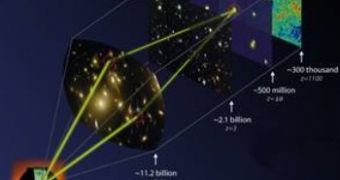Astronomers around the world are thrilled by the latest discovery in the field that pushes the limits of modern space telescopes. They seem to have spotted the farthest galaxies ever found, hiding behind other younger clusters.
Recent evidence show that these galaxies began their existence just 500 million years after the Big Bang, which generated the entire Universe around 13.7 billion years ago. Light from these galaxies traveled for 13 billion years before it was intercepted by Earth-based observatories.
Another extremely interesting thing about this discovery is the fact that astronomers on Earth used a strange natural telescope to boost signals from the distant galaxies, in addition to normal telescopes.
This natural telescope is actually made of foreground clusters, which distorted light coming the oldest and most far-away galaxies, through their huge mass, which bended the rays of light to form a "gravitational lens."
"Gravitational lensing is the magnification of distant sources by foreground structures," explained Caltech astronomer Richard Ellis, who led the international team. "By looking through carefully selected clusters, we have located six star-forming galaxies seen at unprecedented distances, corresponding to a time when the universe was only 500 million years old, or less than 4 percent of its present age."
The team then used the 10-meter-wide Keck Telescope atop Mauna Kea on the Big Island of Hawaii to intercept that distorted light and mathematically compensated for the distortion to get a real image of the most distant galaxies in the background.
This light, produced by half a dozen galaxies considered to be very efficient star nurseries, was amplified 20 times by the magnifying effect of the foreground galaxy cluster, explained team member Dan Stark, a Caltech graduate student.
The find is of crucial importance, since it helps astronomers catch a glimpse of the early age of the Universe, shortly after the first stars began to form.

 14 DAY TRIAL //
14 DAY TRIAL //